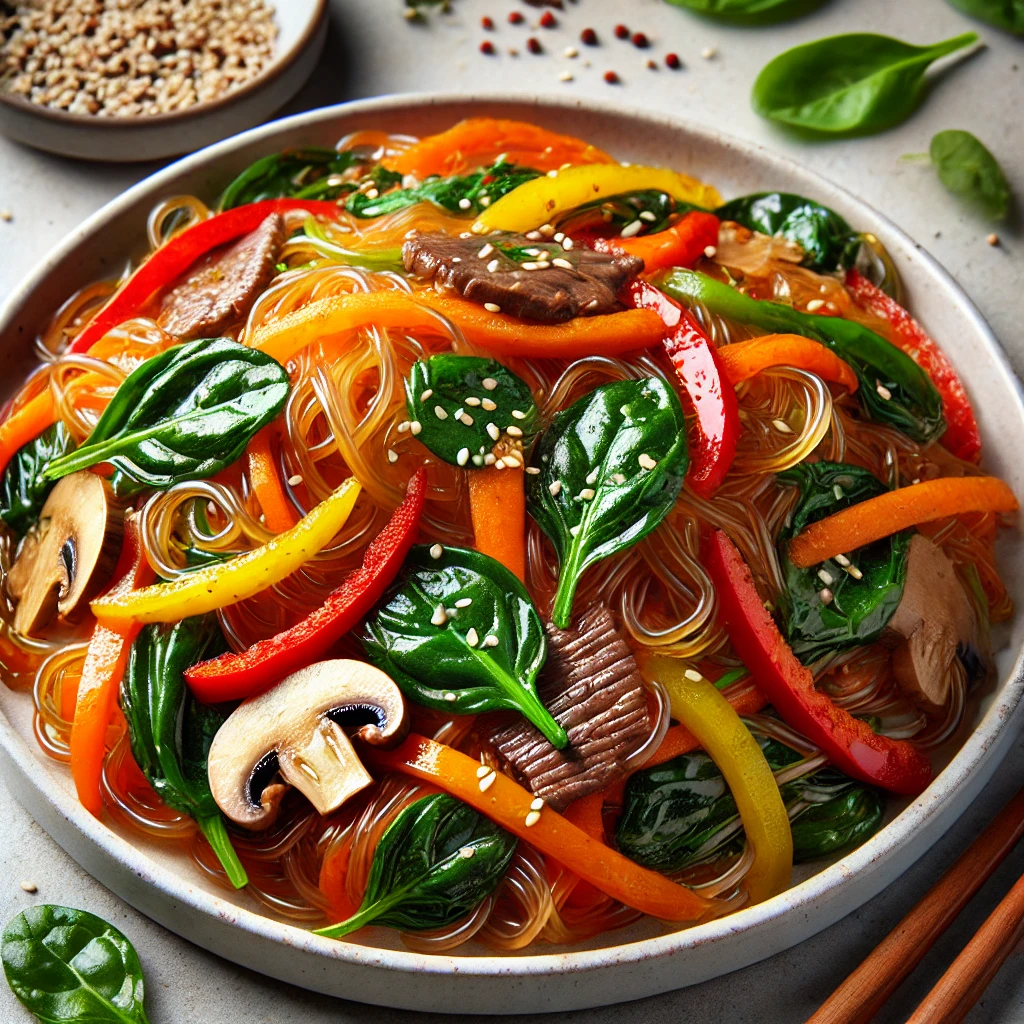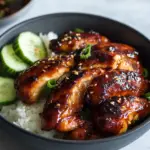Korean cuisine is known for its diverse and flavorful dishes, and Japchae (잡채) is one of its most beloved. Japchae is a stir-fried dish made with sweet potato starch noodles, called dangmyeon, that are chewy and slightly translucent. It’s typically mixed with a variety of vegetables, meat (usually beef), and seasoned with soy sauce, sesame oil, and a touch of sugar for a balanced, savory-sweet flavor. Japchae is a vibrant, colorful dish that can be enjoyed both as a side dish (banchan) or as a main course.
What is Japchae?
Japchae is often referred to as Korean glass noodles because the noodles, made from sweet potato starch, take on a glossy, glass-like appearance after cooking. The dish typically includes sautéed vegetables like carrots, spinach, onions, mushrooms, and bell peppers, which are mixed with the noodles to create a dish that is full of different textures and flavors.
Beef or pork can also be added to japchae, but it can easily be made vegetarian or vegan by omitting the meat. The seasoning for japchae is simple but essential—soy sauce adds umami, sesame oil gives it a rich, nutty flavor, and a touch of sugar rounds out the savory elements with sweetness.
Japchae is often served during special occasions, holidays, and celebrations in Korea, such as Chuseok (Korean Thanksgiving) and New Year’s celebrations, but it is also enjoyed as an everyday dish due to its versatility and easy preparation.
The History of Japchae
The origins of japchae date back to the early 17th century during the Joseon Dynasty. Legend has it that the dish was created by a royal chef for King Gwanghaegun’s palace banquet. The king was so impressed with the dish that it became a royal favorite. Back then, japchae did not include noodles—it was a mix of vegetables and mushrooms. Over time, the recipe evolved, with sweet potato noodles being added in the early 20th century, solidifying the dish we know today.
Japchae is now enjoyed by Koreans of all ages and backgrounds and is often a part of celebratory meals. Its beautiful presentation and balanced flavors make it a symbol of abundance and togetherness during family gatherings.
The Ingredients: The Magic Behind Japchae
While japchae may look complex, it’s made from simple ingredients that come together to create something extraordinary. Here’s what you’ll need to make authentic japchae:
- Dangmyeon (Sweet Potato Noodles): The star of the dish, these glass noodles are naturally gluten-free and made from sweet potato starch. They have a unique chewy texture and absorb the flavors of the sauce beautifully.
- Vegetables: A colorful array of vegetables is what gives japchae its vibrant appearance. Common vegetables used include carrots, spinach, bell peppers, onions, and mushrooms.
- Beef: Thinly sliced beef, usually ribeye or sirloin, is marinated and stir-fried with the vegetables. For a vegetarian or vegan option, tofu or additional mushrooms can be substituted.
- Soy Sauce: The key seasoning for japchae, soy sauce provides the umami base for the dish.
- Sesame Oil: Adds a rich, nutty flavor that’s essential to Korean cooking.
- Sugar: Balances the savory soy sauce with a touch of sweetness.
- Garlic and Green Onions: Garlic is sautéed with the meat and vegetables to enhance the flavor, while green onions are used for a fresh garnish.
- Sesame Seeds: Adds a final nutty crunch when sprinkled on top of the dish.
How to Make Japchae at Home
Japchae is surprisingly easy to make at home, and it can be customized to your preference. Whether you’re making a meat or vegetarian version, here’s a simple recipe to guide you:
Ingredients:
- 200g sweet potato starch noodles (dangmyeon)
- 100g beef (ribeye or sirloin), thinly sliced
- 1 carrot, julienned
- 1/2 onion, thinly sliced
- 1 red bell pepper, julienned
- 100g spinach
- 100g mushrooms (shiitake or button), sliced
- 3 garlic cloves, minced
- 3 tbsp soy sauce
- 1 tbsp sugar
- 2 tbsp sesame oil
- 1 tbsp sesame seeds
- Salt and pepper to taste
Instructions:
- Cook the Noodles: Boil the sweet potato noodles in a pot of water according to the package instructions (usually 6-8 minutes). Drain and rinse with cold water to stop the cooking process. Toss the noodles with a little sesame oil to prevent sticking, and set aside.
- Prepare the Vegetables and Beef:
- Blanch the spinach in boiling water for about 30 seconds, then rinse under cold water. Squeeze out the excess water and set aside.
- Heat a tablespoon of oil in a pan and stir-fry the beef with garlic until browned. Remove from the pan and set aside.
- In the same pan, sauté the onions, carrots, bell peppers, and mushrooms until they soften. Season with a little salt and pepper.
- Season the Noodles: In a large mixing bowl, combine the cooked noodles with soy sauce, sugar, and sesame oil. Add the cooked vegetables, spinach, and beef to the bowl. Mix everything together until well combined.
- Garnish and Serve: Sprinkle sesame seeds on top and garnish with green onions or additional sesame oil if desired. Serve japchae warm or at room temperature as a main dish or a side.
Variations of Japchae
Japchae is a versatile dish that can be customized in many ways:
- Vegetarian Japchae: Simply omit the beef and add more vegetables or tofu for a vegetarian version of the dish. Mushrooms like shiitake or king oyster mushrooms can also provide a meaty texture.
- Spicy Japchae: Add some gochujang (Korean red chili paste) or gochugaru (Korean chili flakes) to give the dish a spicy kick.
- Seafood Japchae: Swap out the beef for shrimp or squid to create a lighter, seafood version of the dish.
Nutritional Benefits of Japchae
Japchae is not only delicious but also packed with nutrients. The sweet potato noodles are naturally gluten-free, making it a great option for those with gluten sensitivities. The assortment of vegetables provides vitamins, minerals, and fiber, while the sesame oil adds healthy fats. The dish is also low in calories but high in flavor, making it a satisfying yet light meal option.
The Cultural Importance of Japchae
Japchae is often enjoyed during celebrations and holidays in Korea. Whether served at weddings, family gatherings, or festivals, it’s a dish that symbolizes abundance and happiness. Its vibrant colors and harmonious balance of flavors reflect Korean culinary philosophy, where every ingredient plays a crucial role in the final dish.
Like many Korean dishes, japchae is meant to be shared. It brings people together around the table, whether during a festive celebration or a simple family meal. The act of cooking japchae, with its careful preparation and balance of ingredients, represents a love of tradition and attention to detail that is at the heart of Korean cuisine.
Conclusion
Japchae is a beautifully balanced dish that brings together the chewy texture of sweet potato noodles, the crispness of stir-fried vegetables, and the savory-sweet flavor of soy sauce and sesame oil. Whether enjoyed as a side dish or a main course, japchae offers a taste of Korea’s rich culinary traditions in every bite. Its versatility and vibrant presentation make it perfect for celebrations, special occasions, or a simple weeknight meal. Once you try it, japchae is sure to become a favorite in your kitchen.






